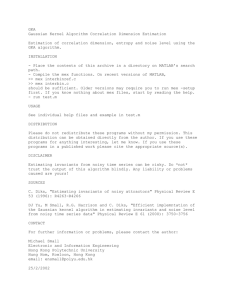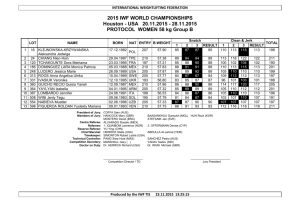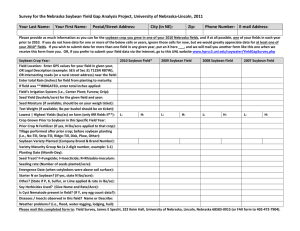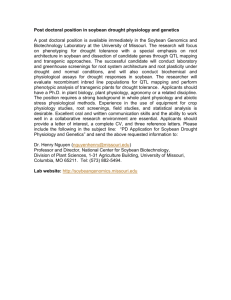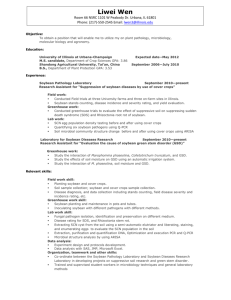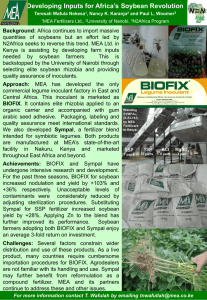CV_Carlos Gongora-Canul_May_2013
advertisement
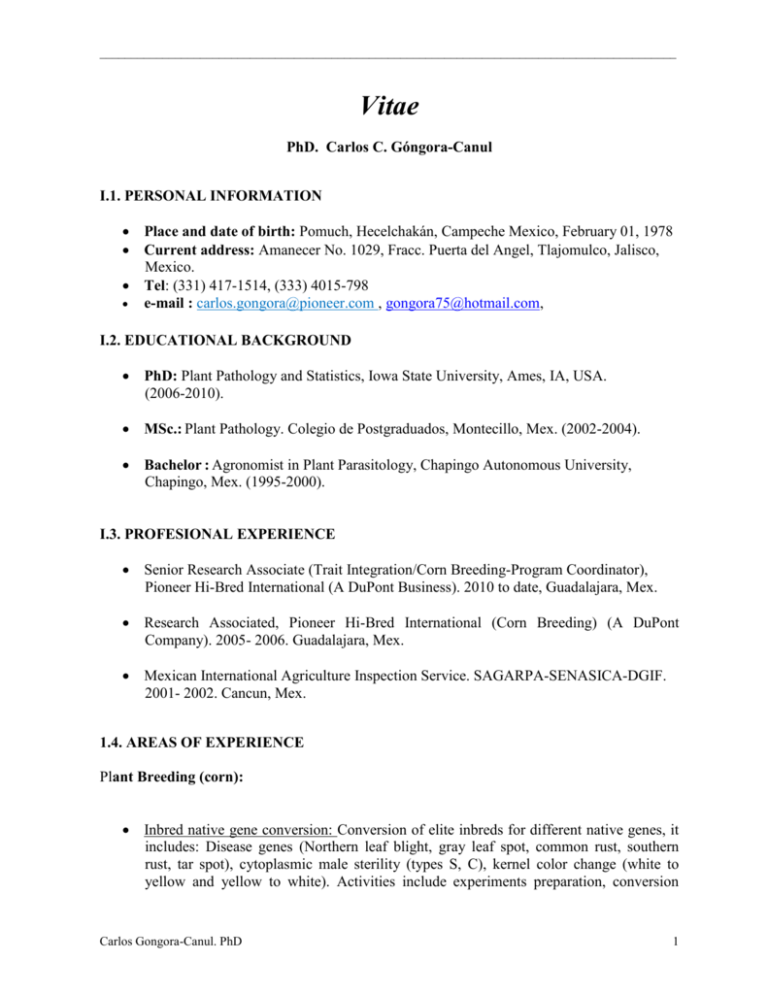
____________________________________________________________________________________________ Vitae PhD. Carlos C. Góngora-Canul I.1. PERSONAL INFORMATION Place and date of birth: Pomuch, Hecelchakán, Campeche Mexico, February 01, 1978 Current address: Amanecer No. 1029, Fracc. Puerta del Angel, Tlajomulco, Jalisco, Mexico. Tel: (331) 417-1514, (333) 4015-798 e-mail : carlos.gongora@pioneer.com , gongora75@hotmail.com, I.2. EDUCATIONAL BACKGROUND PhD: Plant Pathology and Statistics, Iowa State University, Ames, IA, USA. (2006-2010). MSc.: Plant Pathology. Colegio de Postgraduados, Montecillo, Mex. (2002-2004). Bachelor : Agronomist in Plant Parasitology, Chapingo Autonomous University, Chapingo, Mex. (1995-2000). I.3. PROFESIONAL EXPERIENCE Senior Research Associate (Trait Integration/Corn Breeding-Program Coordinator), Pioneer Hi-Bred International (A DuPont Business). 2010 to date, Guadalajara, Mex. Research Associated, Pioneer Hi-Bred International (Corn Breeding) (A DuPont Company). 2005- 2006. Guadalajara, Mex. Mexican International Agriculture Inspection Service. SAGARPA-SENASICA-DGIF. 2001- 2002. Cancun, Mex. 1.4. AREAS OF EXPERIENCE Plant Breeding (corn): Inbred native gene conversion: Conversion of elite inbreds for different native genes, it includes: Disease genes (Northern leaf blight, gray leaf spot, common rust, southern rust, tar spot), cytoplasmic male sterility (types S, C), kernel color change (white to yellow and yellow to white). Activities include experiments preparation, conversion Carlos Gongora-Canul. PhD 1 ____________________________________________________________________________________________ (backcross & self-pollination), gene stacking, phenotypic and genotypic selection; inbred advancement, conversion validation and quality of hybrid assemble. Inbred GMO gene conversion: Conversion of elite inbreds for Herculex, LL (HX1,LL), Yield Guard Corn borer (YGCB), RoundUp Ready (RR2), Seed Production Tech (SPT), Vegetative insecticide protein (VIP). Activities include exp preparation, inbred and hybrid conversion validation, gene stacking and hybrid assemble. Molecular breeding: Include MAS backcrossing, whole genome scan for recurrent parent recuperation, and flaking marker for donor haplotype recovery. Activities include: SNP’s marker selection for whole genome scan and flaking markers and analysis of result of genotypic and phenotypic selection. Hybrid equivalence and effectiveness: Comparison of base hybrid vs. native or GMO hybrids versions to compare agronomic equivalence and protein (GMO-Native) effectiveness. Activities include: Exp. preparation, data taking, data analysis. Plant Pathology: Soybean: Four years 2006-2010 working with Sudden Death Syndrome of soybean. Other diseases include white mold, frog eye, septoria brown spot, bacterial blight, cercospora leaf blight, mildews. Activities included: Field plantings, soybean disease characterization. In lab, PCR identification of pathogens, inoculums preparation and preservation. Inoculation in field and greenhouse. Inbred screening for disease resistant. Corn: Two years working with corn pathology, diseases included are: Northern leaf blight, head smut, common smut, gray leaf spot, late wilt, anthracnose, common rust, southern rust, tar spot. Activities included diagnosis, field inspections, inbred and hybrid disease scoring, inoculums preparation and inoculation techniques. Citrus Two years working with citrus tristeza cloterovirus. Statistics Statistical methods, theoretical statistics, experimental design, sampling methods, multivariate analysis, temporal and spatial analysis, and ecological statistics. 1.5. LANGUAGE AND SOFTWARES English (95%) and Spanish (100%). Microsoft office (Word & Excel), SAS®, MatLab®, R, GS+®, Surfer®, LCOR2, etc. Carlos Gongora-Canul. PhD 2 ____________________________________________________________________________________________ 1.6. DEVELOPED COMPANY PRODUCTS New inbreds and hybrids resistant to diseases (experimental and commercial) New inbred and hybrid version with new kernels colors (experimental and commercial) CMS female inbreds for commercial seed production (experimental and commercial) GMO inbred and hybrid development Novel method to estimate corn root density Novel method to extract DNA for Spodoptera frugiperda I.7. PUBLICATIONS M. A. Ferreira, T. C. Harrington, C. C. Gongora-Canul, R. G. Mafia, E. A. V.Zauza, A. C. Alfenas. 2012. Spatial-temporal patterns of Ceratocystis wilt in eucalyptus plantations in Brazil. Forest Pathology. doi: 10.1111/efp.12013 Gongora-Canul, C., Nutter, F. W. Jr., and Leandro, L. F. S. 2011. Temporal dynamics of root and foliar symptoms of soybean sudden death syndrome. Eur. J. Plant Pathol: 132:71-79. Gongora-Canul, C. C. and Leandro, L. F. S. 2011. Plant age affects root infection and development of foliar symptoms of soybean sudden death syndrome. Plant Disease 95: 242-247 Gongora-Canul, C. C., and Leandro, L. F. S. 2011. Effect of soil temperature and plant age at time of inoculation on progress of root rot and foliar symptoms of soybean sudden death syndrome. Plant Disease 95:436-440 Silva-Rojas, H. V., Fernández-Pavía, S. P., Gongora-Canul, C. y Ávila-Quezada, G. D. 2009. Spatial-temporal distributions of pepper wilt (Capsicum annum L.) in Chihuahua and identification of the causal agent Phytophthora capsici Leo. Revista Mexicana de Fitopatología 27:134-147. Ruiz-García, N., Mora-Aguilera, G. Rivas-Valencia, P., Gongora-Canul, C., LoezaKuk, E. Ochoa-Martínez, D., Ramírez-Valverde, G., Gutierrez-Espinosa, M. A. y Álvarez-Ramos, R. 2009. Reliability of direct tissue BLOT-ELISA and DAS-ELISA in the detection of citrus tristeza virus and sampling in commercial plots of Tamaulipas México. Revista Chapingo Serie Horticultura 15:41-47 Góngora-Canul, C., Escamilla-Bencomo, J. Pérez-Hernández, O. y Mora-Aguilera, G. 2004. Spread gradients of lethal yellowing of coconut (Cocos nucifera L.) in Sisal Yucatán, México. Revista Mexicana de Fitopatología 22:370-376. Pérez-Hernández, O., Gongora-Canul, C., Medina-Lara, F. M., Oropeza-Salím, C., Escamilla-Bencomo, J. A, y Mora-Aguilera, G. 2004. Spatio-temporal pattern of lethal Carlos Gongora-Canul. PhD 3 ____________________________________________________________________________________________ yellowing of coconut (Cocos nicifera L.) in Yucatán, México. Revista Mexicana de Fitopatología 22:231-238. Gongora-Canul, C. and Leandro, L.F.S 2009. Effect of soil temperature and plant age on root rot and foliar symptoms of soybean sudden death syndrome. Phytopathology 99:S45 Lim, K. Gongora, C., Caragea, P., and Leandro, L. 2009. Effect of planting density, SCN population, and soil pH on soybean root rot. (Abstr.) Proc APS-NCR. 7: G-17. Gongora-Canul, C. and Leandro, L.F.S 2008. Window of opportunity for root infection leading to foliar symptoms of soybean sudden death syndrome. Phytopathology 98:S60. Gongora-Canul, C., Nutter, F. W. Jr. and Leandro, L. F.S. 2008. Temporal dynamics of root and foliar symptoms of soybean symptoms sudden death syndrome at different inoculum densities. (Abstr.) Proc. South. Soybean Dis. Work. Conf. 35: 12. Gongora-Canul, C. and Leandro, L.F.S. 2007. Effect of inoculum level of Fusarium virguliforme on timing of foliar and root symptom expression of soybean sudden death syndrome. Phytopathology 97: S41. Góngora-Canul, C.; Mora-Aguilera, G.; Loeza-Kuk, E.; Rivas-Valencia, P.; RuízGarcía, N.; Ortíz-Solorio, C.; Ochoa-Martínez, D.; Álvarez-Ramos, R. y GutiérrezEspinosa, A. 2004. Regional Mapping of CTV using statistical multivariate methods, in Tamaulipas, Mexico..(Abstr.) Proc. Cong. Br. Fitopathol. 37. Góngora, C. C, Mora, A. G., Kwuang-Soo, K., Ortiz, S. C., Gleason, M. L., Álvarez, R. R. y Ochoa, M. D. 2004. Application of two interpolation methods of temperature at regional level.d (Abstr.) Proc. 1st Nat. Cong. Agr. Phenol. 1:33 Góngora-Canul, C.; Rivas-Valencia, P.; Ruiz-García, N; Loeza-Kuk, E., MoraAguilera, G.; Ochoa-Martínez, D.; Gutiérrez-Espinosa, M. A and Álvarez-Ramos, R Spatial Pattern of Citrus Tristeza in Tamaulipas, México. 2004. Phytopathology 94: S35. Góngora-Canul, C.; Rivas-Valencia, P.; Ruiz-García, N; Loeza-Kuk, E., MoraAguilera, G.; Ochoa-Martínez, D.; Gutiérrez-Espinosa, M. A, and Álvarez-Ramos, R. 2005. Spatial epidemiology of CTV in México: Índices, GIS and geoestatics. (Abstr.) Proc. Int. Org. Citrus Vir. 16:495 Góngora-Canul, C., Escamilla- Bencomo, J., Pérez-Hernández, O. y Mora-Aguilera, G. 2000. Gradientes de dispersión del amarillamiento letal del cocotero (Cocos nucifera L.) en Yucatán y Campeche. (Abstr.) Mex. Phytopahol Soc. 27: L77 Carlos Gongora-Canul. PhD 4 ____________________________________________________________________________________________ Pérez-Hernández, O., Mora-Aguilera, G., Escamilla- Bencomo, J. y Góngora-Canul, C. 2000. Patrón espacio-temporal del amarillamiento letal del cocotero (Cocos nucifera L.) en Yucatán, México. (Abstr.) Mex. Phytopahol Soc. 27: L84 Kim, K. S., Gleason, M. L. and Góngora-Canul, 2004. Site-specific estimation of weather variables in mid-western U.S. using spatial interpolation. Phytopathology 94:S52 I.8. PROFESSIONAL MEETINGS Global Trait Integration Technology Meeting in Corn. DuPont Pioneer Hi-Bred International. January, 2013.San Juan, Puerto Rico Conference Speaker: “Foro Nacional sobre Maiz Geneticamente Modificado”, SENASICA. Julio, 2012, Guadalajara, Mexico. Conference Speaker-Training: “Accelerated Trait Integration in Pioneer Hi-Bred”, May, 2012, Waimea, Kauai, Hawaii, USA. Magisterial Conference Speaker “The Biotechnology in Corn Breeding”. January, 2012. Santiago de Veraguas. Republic of Panama. Annual meeting of “Biotechnology of GMO crops”. September, 2011. McAllen, Texas, USA. Speaker “Triat Integration Technology”, March, 2011. Salinas, Puerto, Rico. Conference “The Graduate Studies in USA: Implication and General information” August, 2010.Calkini, Campeche, Mex. Annual meeting of the American Phytopathological Society. August, 2009. Portland, Oregon, USA. Annual meeting of the American Phytopathological Society-North Central Region, June, 2009.Ames, Iowa, USA. Annual meeting of the American Phytopathological Society. July, 2008. Minneapolis. Minnesota, USA. Thirty-Fifth Annual meeting of Southern Soybean Disease Workers. March, 2008. Pensacola, Florida, USA. Carlos Gongora-Canul. PhD 5 ____________________________________________________________________________________________ Annual Workshop of the North Central Soybean Research Program. Nov., 2007. University of Illinois at Urbana-Champaign, USA. Annual meeting of the American Phytopathological Society. July, 2007. San Diego, California USA. Annual Workshop of the North Central Soybean Research Program. Nov., 2006. Southern Illinois University Carbondale, Illinois, USA Seminar series speaker “Epidemiology of Citrus Tristeza Virus in Mexico”. Feb. 2004. Dept. of Plant Pathology, Iowa State University. Ames, Iowa, USA. Invited speaker “The Plant Pathology Status in the Americas”. May, 2004. Dept. of Plant Parasitology. Chapingo Autonomous University, Chapingo, México. Attendant to the “National Inspection Service Updates in Ports, Airports and Borders. Sep. 2001. Mérida, Yucatán, Mex. Invited speaker “Spread Gradients and Spatial Pattern of Lethal Yellowing of Coconut in Yucatan and Campeche Sates, Mexico”. Instituto Tecnológico Agropecuario No 5. Mex. 2000. Chiná, Campeche, Mex. Attendant to the “Agro-Business for Young Entrepreneur”. May. 2000. Chapingo Autonomous University, Chapingo. Chapingo, Mex. Seminar attendant "Leadership and Professional Development". April, 1999. Chapingo Autonomous University, Chapingo, Mex. Seminar Attendant “Pesticides in Agriculture”. Nov., 1999. Chapingo Autonomous University, Chapingo, Mex. Symposium attendant “ Phytosanitary Legislation and Job Perspective of the Agronomist” Nov., 1998. Chapingo Autonomous University, Chapingo, Mex. I.9. ACADEMIC ACTIVITIES Teaching Plant Disease Epidemiology Course (PLP 534), Fall 2009. Department of Plant Pathology, Iowa State University, Ames, IA, USA. Statistical Methods for Research Course (STAT, 401), Fall, 2009. Hixson-Lied Student Success Center, Iowa State University, Ames, IA, USA. Carlos Gongora-Canul. PhD 6 ____________________________________________________________________________________________ Study Abroad Course, Spring 2008. International Study Center, Iowa State University, Ames, IA, USA. Adviser Bachelor Thesis: Jose G. Campos Martinez Bachelor Degree in Agronomy 2012. Techniques to Study Temporal Growth Dynamic of Corn Roots and Novel Technique to Estimate Corn Root Density. Universidad Autonoma Agraria Antonio Narro-Pioneer Hi-Bred Int. Saltillo Coahuila, Mex Bachelor Thesis: Oscar Sereno-Pareja, Bachelor degree in Agronomy 2006. Spatial distribution of Spodoptera frugiperda within field scale. Agricultural Technological Institute No 26. Tlajomulco Jalisco, Mex. I. 10. HONORS AND AWARDS Phi Beta Delta, honor society, Iowa State Chapter. Second Place, Grad Student Research Competition. 2008. South. Soybean Dis. Work. Conf. Pensacola, FL., USA. Honor roll member, 1998-1999. Chapingo Autonomous University. Chapingo, Mex. Scholarship from, Mexican National Council for Science and Technology (CONACyT), 2008-2010. Scholarship from “Pablo Garcia Foundation” 2006-2007 Campeche Mexican State Government, Scholarship from Mexican State Council of Science and Technology, 2004. I.11. EXTRACURRICULAR ACTIVITIES Plant Pathology Student Organization President, 2008-2009. Iowa State University, Ames, IA, USA. Campeche State Student Organization President, 1998-2000. Chapingo Autonomous University. Chapingo, Mex. Carlos Gongora-Canul. PhD 7
